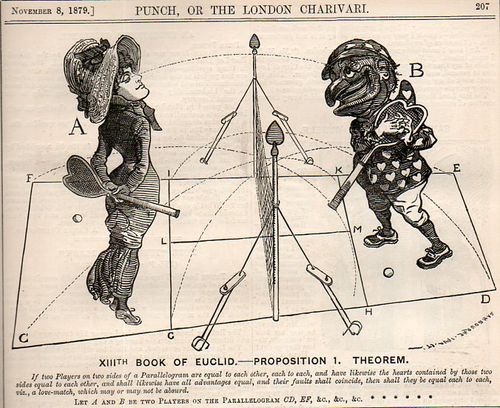JF Ptak Science Books Post 1603 {The History of Lines series.]
If you give them a chance, physics and the maths will provide their own fairy tales.
This lovely trompe l'oeil of Euclid calls into play the play of love, in hard angles and parabolas, between Mr. Punch of Punch or the London Charivari and the object of his affection. The image was published on 8 November 1879--just three days after the death of one of the greatest line-makers of the 19th century, James Clerk Maxwell. (There is no mention of JCM anywhere in Punch, and I guess probably that there needn't be, even if he was one of the greatest thinkers of the nineteenth (or any other) century.)
"XIIITH BOOK OF EUCLID.—PROPOSITION 1. THEOREM.
If two Players on two sides of a Parallelogram are equal to each other, each to each, and have likewise the hearts contained by those two side» equal to each other, and shall likewise have all advantages equal, and their faulty shall coincide, then shall they be equal each to each, viz., a love-match, which may or may not be absurd."
Maxwell's really big lines come in a series of four papers called "On the Lines of Force"1, and were published in 1861 and 1862. It is in these papers that Maxwell's famous equations are all found, and it is also the place where we'll find the basis not only for the foundation of classical electrodynamics, but the forms for the structure of what would become the epochal/modern communication/electrical technologies.
- 1 Part I: The Theory of Molecular Vortices applied to Magnetic Phenomena
- 2 Part II: The Theory of Molecular Vortices applied to Electric Currents
- 3 Part III: The Theory of Molecular Vortices applied to Statical Electricity
- 4 Part IV: The Theory of Molecular Vortices applied to the Action of Magnetism on Polarized Light
- 5 Footnotes






Comments